Geotechnology Applied to Analysis of Vegetation Dynamics and Occurrence of Forest Fires on Indigenous Lands in Cerrado-Amazonia Ecotone
Abstract
1. Introduction
2. Materials and Methods
2.1. Study Area
2.2. Obtaining and Pre-Processing Data
2.3. Obtaining and Processing Meteorological Data
2.4. Temporal Analysis of Burnt Areas
2.5. Time Series Analysis
2.5.1. Analysis of Trends, Correlations and Lags
2.5.2. Mann–Kendall Monotonic Trends
2.5.3. Vegetation Seasonality
2.5.4. NDVI Anomalies, Rainfall and Burnt Area
3. Results
3.1. Linear Modeling
3.2. Time Profiles and Anomalies
3.3. Mann–Kendall Monotonic Trend
3.4. NDVI Seasonality
4. Discussion
4.1. Linear Modeling: NDVI X TRMM
4.2. Linear Modeling: Burnt Area and Vegetation Index
4.3. Linear Modeling: Burnt Area X Rainfall
4.4. Temporal Profile
4.5. Anomalies
4.6. Mann–Kendall Monotonic Trend
4.7. NDVI Seasonality
5. Conclusions
Supplementary Materials
Author Contributions
Funding
Acknowledgments
Conflicts of Interest
References
- Gallois, D.T. Instituto Socioambiental: Povos Indígenas No Brasil. Available online: https://pib.socioambiental.org/pt/Localização_e_extensão_das_TIs (accessed on 1 January 2019).
- Lima, M.; Vale, J.C.E.D.; Costa, G.D.M.; dos Santos, R.C.; Filho, W.L.F.C.; Gois, G.; de Oliveira-Junior, J.F.; Teodoro, P.E.; Rossi, F.S.; Junior, C.A.D.S. The forests in the indigenous lands in Brazil in Peril. Land Use Policy 2020, 90, 104258. [Google Scholar] [CrossRef]
- Zimmerman, B.; Peres, C.A.; Malcolm, J.R.; Turner, T. Conservation and development alliances with the Kayapó of south-eastern Amazonia, a tropical forest indigenous people. Environ. Conserv. 2001, 28, 10–22. [Google Scholar] [CrossRef]
- Silva, E.C.D.A. Povos indígenas e o direito à terra na realidade brasileira. Serviço Soc. Soc. 2018, 480–500. [Google Scholar] [CrossRef]
- Welch, J.R.; Santos, R.V.; Flowers, N.M.; Coimbra, C.E.A., Jr. Na primeira margem do rio: Território e ecologia do povo xavante de wedezé. Cad. Public Health 2013, 30, 248. [Google Scholar]
- De Melo, M.M.; Saito, C.H. The practice of burning savannas for hunting by the xavante Indians based on the stars and constellations. Soc. Nat. Resour. 2013, 26, 478–487. [Google Scholar] [CrossRef]
- Strassburg, B.B.N.; Brooks, T.; Feltran-Barbieri, R.; Iribarrem, A.; Crouzeilles, R.; Loyola, R.; Latawiec, A.E.; Oliveira Filho, F.J.B.; De Scaramuzza, C.A.M.; Scarano, F.R.; et al. Moment of truth for the Cerrado hotspot. Nat. Ecol. Evol. 2017, 1, 99. [Google Scholar] [CrossRef]
- Barbieri, A.R.M.; Szabó, M.P.J.; Costa, F.B.; Martins, T.F.; Soares, H.S.; Pascoli, G.; Torga, K.; Saraiva, D.G.; Ramos, V.N.; Osava, C.; et al. Species richness and seasonal dynamics of ticks with notes on rickettsial infection in a natural park of the Cerrado biome in Brazil. Ticks Tick. Borne. Dis. 2019, 10, 442–453. [Google Scholar] [CrossRef] [PubMed]
- Neary, D.G.; Ryan, K.C.; DeBano, L.F. Wildland Fire in Ecosystems, Effects of Fire on Soil and Water; USDA-FS General Technical Report; U.S. Department of Agriculture, Forest Service, Rocky Mountain Research Station: Ogden, UT, USA, 2005; Volume 4, 250p, ISBN 9704981392.
- Fiedler, N.C.; Nuno, I.; De Azevedo, C.; De Medeiros, M.B.; Venturoil, F. Efeito de incêndios florestais na estrutura E composição effect of fire onthe structure and floristic composition of a Cerrado sensu stricto area in fazenda água limpa-Df. Rev. Árvore 2002, 28, 129–138. [Google Scholar] [CrossRef]
- Gomes, L.; Miranda, H.S.; Bustamante, M.M.D.C. How can we advance the knowledge on the behavior and effects of fire in the Cerrado biome? For. Ecol. Manag. 2018, 417, 281–290. [Google Scholar] [CrossRef]
- Bendini, H.D.N.; Garcia Fonseca, L.M.; Schwieder, M.; Sehn Körting, T.; Rufin, P.; Del Arco Sanches, I.; Leitão, P.J.; Hostert, P. Detailed agricultural land classification in the Brazilian Cerrado based on phenological information from dense satellite image time series. Int. J. Appl. Earth Obs. Geoinf. 2019, 82, 101872. [Google Scholar] [CrossRef]
- Machado, R.B.; Neto, M.G.P.; Caldas, E.F.; Gonçalves, D.A.; Santos, N.A.; Tabor, K.; Steininger, M. Estimativas de perda da área do Cerrado Brasileiro. Int. Bras. 2004, 1–23. [Google Scholar] [CrossRef][Green Version]
- Cairney, J.W.G.; Bastias, B.A. Slash burning, faunal composition, and nutrient dynamics in a Eucalyptus grandis plantation in South Africathis. Article is one of a selection of papers published in the special forum on towards sustainable forestry—The living soil: Soil biodiversity and functions. Can. J. For. Res. 2007, 37, 226–235. [Google Scholar] [CrossRef]
- Jesús, S.-M.-A.; Schulte, E.; Schmuck, G.; Camia, A.; Strobl, P.; Liberta, G.; Giovando, C.; Boca, R.; Sedano, F.; Kempeneers, P.; et al. Comprehensive monitoring of wildfires in Europe: The European forest fire information system (EFFIS). In Approaches to Managing Disaster—Assessing Hazards, Emergencies and Disaster Impacts; Tiefenbacher, P.J., Ed.; IntechOpen: London, UK, 2012; pp. 87–108. ISBN 978-953-51-0294-6. [Google Scholar]
- Pausas, J.G.; Vallejo, V.R. The role of fire in European Mediterranean ecosystems. In Remote Sensing of Large Wildfires in the European Mediterranean Basin; Springer: Berlin/Heidelberg, Germany, 1999; pp. 3–16. [Google Scholar]
- French, N.H.F.; Kasischke, E.S.; Williams, D.G. Variability in the emission of carbon-based trace gases from wildfire in the Alaskan boreal forest. J. Geophys. Res. 2003, 108, 8151. [Google Scholar] [CrossRef]
- Gomes, L.; Miranda, H.S.; Silvério, D.V.; Bustamante, M.M.C. Effects and behaviour of experimental fires in grasslands, savannas, and forests of the Brazilian Cerrado. For. Ecol. Manag. 2020, 458, 8. [Google Scholar] [CrossRef]
- Pettorelli, N.; Vik, J.O.; Mysterud, A.; Gaillard, J.M.; Tucker, C.J.; Stenseth, N.C. Using the satellite-derived NDVI to assess ecological responses to environmental change. Trends Ecol. Evol. 2005, 20, 503–510. [Google Scholar] [CrossRef] [PubMed]
- Tagliabue, G.; Panigada, C.; Celesti, M.; Cogliati, S.; Colombo, R.; Migliavacca, M.; Rascher, U.; Rocchini, D.; Schüttemeyer, D.; Rossini, M. Sun–induced fluorescence heterogeneity as a measure of functional diversity. Remote Sens. Environ. 2020, 247, 111934. [Google Scholar] [CrossRef]
- Tian, F.; Brandt, M.; Liu, Y.Y.; Verger, A.; Tagesson, T.; Diouf, A.A.; Rasmussen, K.; Mbow, C.; Wang, Y.; Fensholt, R. Remote sensing of vegetation dynamics in drylands: Evaluating vegetation optical depth (VOD) using AVHRR NDVI and in situ green biomass data over West African Sahel. Remote Sens. Environ. 2016, 177, 265–276. [Google Scholar] [CrossRef]
- Wimberly, M.C.; Reilly, M.J. Assessment of fire severity and species diversity in the southern Appalachians using landsat TM and ETM+ imagery. Remote Sens. Environ. 2007, 108, 189–197. [Google Scholar] [CrossRef]
- Giglio, L.; Loboda, T.; Roy, D.P.; Quayle, B.; Justice, C.O. An active-fire based burned area mapping algorithm for the MODIS sensor. Remote Sens. Environ. 2009, 113, 408–420. [Google Scholar] [CrossRef]
- Dalponte, M.; Marzini, S.; Solano-Correa, Y.T.; Tonon, G.; Vescovo, L.; Gianelle, D. Mapping forest windthrows using high spatial resolution multispectral satellite images. Int. J. Appl. Earth Obs. Geoinf. 2020, 93, 102206. [Google Scholar] [CrossRef]
- Harris, S.; Veraverbeke, S.; Hook, S. Evaluating spectral indices for assessing fire severity in chaparral ecosystems (Southern California) using modis/aster (MASTER) airborne simulator data. Remote Sens. 2011, 3, 2403–2419. [Google Scholar] [CrossRef]
- Justice, C.O.; Townshend, J.R.G.; Vermote, E.F.; Masuoka, E.; Wolfe, R.E.; Saleous, N.; Roy, D.P.; Morisette, J.T. An overview of MODIS land data processing and product status. Remote Sens. Environ. 2002, 83, 3–15. [Google Scholar] [CrossRef]
- Roy, D.P.; Boschetti, L.; Trigg, S.N. Remote sensing of fire severity: Assessing the performance of the normalized burn ratio. IEEE Geosci. Remote Sens. Lett. 2006, 3, 112–116. [Google Scholar] [CrossRef]
- Crimmins, T.M.; Crimmins, M.A.; David Bertelsen, C. Complex responses to climate drivers in onset of spring flowering across a semi-arid elevation gradient. J. Ecol. 2010, 98, 1042–1051. [Google Scholar] [CrossRef]
- Meier, G.A.; Brown, J.F.; Evelsizer, R.J.; Vogelmann, J.E. Phenology and climate relationships in aspen (Populus tremuloides Michx.) forest and woodland communities of southwestern Colorado. Ecol. Indic. 2015, 48, 189–197. [Google Scholar] [CrossRef]
- De Jong, R.; Verbesselt, J.; Schaepman, M.E.; De Bruin, S. Trend changes in global greening and browning: Contribution of short-term trends to longer-term change. Glob. Chang. Biol. 2012, 18, 642–655. [Google Scholar] [CrossRef]
- Forkel, M.; Carvalhais, N.; Verbesselt, J.; Mahecha, M.D.; Neigh, C.S.R.; Reichstein, M. Trend change detection in NDVI time series: Effects of inter-annual variability and methodology. Remote Sens. 2013, 5, 2113–2144. [Google Scholar] [CrossRef]
- Abdi, O.; Kamkar, B.; Shirvani, Z.; Silva, J.A.T.; Buchroithner, M.F. Spatial-statistical analysis of factors determining forest fires: A case study from Golestan, Northeast Iran. Geomat. Nat. Hazards Risk 2018, 9, 267–280. [Google Scholar] [CrossRef]
- Mota, P.H.S.; Rocha, S.J.S.S.; Castro, N.L.M.; Marcatti, G.E.; França, L.C.J.; Schettini, B.L.S.; Villanova, P.H.; Santos, H.T.; Santos, A.R. Forest fire hazard zoning in Mato Grosso state, Brazil. Land Use Policy 2019, 88, 104206. [Google Scholar] [CrossRef]
- Alvares, C.A.; Stape, J.L.; Sentelhas, P.C.; de Moraes Gonçalves, J.L.; Sparovek, G. Köppen’s climate classification map for Brazil. Meteorol. Z. 2013, 22, 711–728. [Google Scholar] [CrossRef]
- NASA MODIS—Moderate Resolution Imaging Spectroradiometer. Available online: https://modis.gsfc.nasa.gov/about/design.php (accessed on 2 January 2021).
- Didan, K.; Munoz, A.B.; Solano, R.; Huete, A. MODIS Vegetation Index User ’s Guide (Collection 6); The University of Arizona: Tucson, AZ, USA, 2015. [Google Scholar]
- JAXA—Japan Aerospace Exploration Agency Tropical Rainfall Measuring Mission (TRMM). Available online: https://global.jaxa.jp/projects/sat/trmm/ (accessed on 1 February 2020).
- Boschetti, L.; Roy, D.; Hoffman, A.A.; Humber, M. MODIS Collection 5 Burned Area Product MCD45. Version 1. 2015. Available online: https://modis-fire.umd.edu/files/MODIS_Burned_Area_Collection51_User_Guide_3.1.0.pdf (accessed on 25 March 2022).
- Mann, H.B. Nonparametric tests against trend. Econometrica 1945, 13, 245. [Google Scholar] [CrossRef]
- Kendall, M.G. Rank Correlation Measures, 4th ed.; Charles Griffin: London, UK, 1975; ISBN 0195208374. [Google Scholar]
- Beurs, K.M.; Wright, C.K.; Henebry, G.M. Dual scale trend analysis for evaluating climatic and anthropogenic effects on the vegetated land surface in Russia and Kazakhstan. Environ. Res. Lett. 2009, 4, 45012. [Google Scholar] [CrossRef]
- Santos, G.M.; Melendez-Pastor, I.; Navarro-Pedreño, J.; Koch, M. Assessing water availability in Mediterranean regions affected by water conflicts through MODIS data time series analysis. Remote Sens. 2019, 11, 1355. [Google Scholar] [CrossRef]
- Schulze, E. Vapor exchange in response to drought in the atmosphere and in the soil 1. Plant Physiol. 1986, 37, 247–274. [Google Scholar] [CrossRef]
- Huete, A.R.; Didan, K.; Shimabukuro, Y.E.; Ratana, P.; Saleska, S.R.; Hutyra, L.R.; Yang, W.; Nemani, R.R.; Myneni, R. Amazon rainforests green-up with sunlight in dry season. Geophys. Res. Lett. 2006, 33, 2–5. [Google Scholar] [CrossRef]
- Wang, J.; Rich, P.M.; Price, K.P. Temporal responses of NDVI to precipitation and temperature in the central great plains, USA. Int. J. Remote Sens. 2003, 24, 2345–2364. [Google Scholar] [CrossRef]
- Herrmann, S.M.; Anyamba, A.; Tucker, C.J. Recent trends in vegetation dynamics in the African Sahel and their relationship to climate. Glob. Environ. Chang. 2005, 15, 394–404. [Google Scholar] [CrossRef]
- Hulme, M. Climatic perspectives on Sahelian desiccation: 1973–1998. Glob. Environ. Chang. 2001, 11, 19–29. [Google Scholar] [CrossRef]
- Archibald, S.; Scholes, R.J. Leaf green-up in a semi-arid African Savanna: Separating tree and grass responses to environmental cues. J. Veg. Sci. 2007, 18, 583–594. [Google Scholar] [CrossRef]
- Bucci, S.J.; Scholz, F.G.; Goldstein, G.; Meinzer, F.C.; Franco, A.C.; Zhang, Y.; Hao, G.Y. Water relations and hydraulic architecture in Cerrado trees: Adjustments to seasonal changes in water availability and evaporative demand. Braz. J. Plant Physiol. 2008, 20, 233–245. [Google Scholar] [CrossRef]
- Correia Filho, W.L.F.; Oliveira-Júnior, J.F.; Barros Santiago, D.; Bodas Terassi, P.M.; Teodoro, P.E.; De Gois, G.; Blanco, C.J.C.; De Almeida Souza, P.H.; da Silva Costa, M.; Gomes, H.B.; et al. Rainfall variability in the Brazilian northeast biomes and their interactions with meteorological systems and ENSO via CHELSA product. Big Earth Data 2019, 3, 315–337. [Google Scholar] [CrossRef]
- Richardson, A.D.; Andy Black, T.; Ciais, P.; Delbart, N.; Friedl, M.A.; Gobron, N.; Hollinger, D.Y.; Kutsch, W.L.; Longdoz, B.; Luyssaert, S.; et al. Influence of spring and autumn phenological transitions on forest ecosystem productivity. Philos. Trans. R. Soc. B Biol. Sci. 2010, 365, 3227–3246. [Google Scholar] [CrossRef]
- Gallinat, A.S.; Primack, R.B.; Wagner, D.L. Autumn, the neglected season in climate change research. Trends Ecol. Evol. 2015, 30, 169–176. [Google Scholar] [CrossRef]
- Kong, D.; Miao, C.; Wu, J.; Zheng, H.; Wu, S. Time lag of vegetation growth on the loess plateau in response to climate factors: Estimation, distribution, and influence. Sci. Total Environ. 2020, 744, 140726. [Google Scholar] [CrossRef]
- Kuntschik, G. Estimativa de Biomassa Vegetal Lenhosa Em Cerrado Por Meio de Sensoriamento Remoto Óptico e de Radar. Ph.D. Thesis, Universidade de São Paulo, São Paulo, Brazil, 2004. [Google Scholar]
- Liu, Y.; Hill, M.J.; Zhang, X.; Wang, Z.; Richardson, A.D.; Hufkens, K.; Filippa, G.; Baldocchi, D.D.; Ma, S.; Verfaillie, J.; et al. Using data from landsat, MODIS, VIIRS and phenocams to monitor the phenology of California oak/grass savanna and open grassland across spatial scales. Agric. For. Meteorol. 2017, 237–238, 311–325. [Google Scholar] [CrossRef]
- Derner, J.D.; Hess, B.W.; Olson, R.A.; Schuman, G.E. Functional group and species responses to precipitation in three semi-arid rangeland ecosystems. Arid Land Res. Manag. 2008, 22, 81–92. [Google Scholar] [CrossRef]
- Herrera, M.C.P.; Correa, C.A.P. An Assessment of El Niño and La Niña impacts focused on monthly and seasonal rainfall and extreme dry/precipitation events in mountain regions of Colombia and México. Adv. Geosci. 2016, 42, 23–33. [Google Scholar] [CrossRef]
- Klink, C.A.; Solbrig, O.T. Efeito do fogo na biodiversidade de plantas do Cerrado. In Biodiversidad y Funcionamiento de Pastizales y Sabanas en America Latina; Sarmiento, G., Cabido, M., Eds.; Cyted y Cielat: Merida, Venezuela, 1996; pp. 231–244. [Google Scholar]
- Miranda, H.S.; Bustamante, M.M.C.; Miranda, A.C. The fire factor. In The Cerrados of Brazil: Ecology and Natural History of a Neotropical Savanna; Columbia University Press: Chichester, UK, 2002; pp. 51–68. ISBN 0231120427. [Google Scholar]
- Schmidt, M.W.I.; Torn, M.S.; Abiven, S.; Dittmar, T.; Guggenberger, G.; Janssens, I.A.; Kleber, M.; Kögel-Knabner, I.; Lehmann, J.; Manning, D.A.C.; et al. Persistence of soil organic matter as an ecosystem property. Nature 2011, 478, 49–56. [Google Scholar] [CrossRef] [PubMed]
- Durigan, G. Zero-fire: Not possible nor desirable in the Cerrado of Brazil. Flora Morphol. Distrib. Funct. Ecol. Plants 2020, 268, 151612. [Google Scholar] [CrossRef]
- Mayaux, P.; Holmgren, P.; Achard, F.; Eva, H.D.; Stibig, H.-J.J.; Branthomme, A. Tropical forest cover change in the 1990s and options for future monitoring. Philos. Trans. R. Soc. Lond. B. Biol. Sci. 2005, 360, 373–384. [Google Scholar] [CrossRef]
- Moreira, T.R.; Ferreira, S.; Marques, S.; Souza, K.B.; Senhorelo, A.P.; Heitor, F.D.; Parajara, C.; Ribeiro, W.R.; Gonçalves, M.S.; Pinheiro, A.A.; et al. Thermal favorability for the Oidium caricae and Asperisporium caricae in areas of edaphoclimatic aptitude for the Carica papaya. J. Therm. Biol. 2020, 92, 45. [Google Scholar] [CrossRef]
- Pirovani, D.B.; Pezzopane, J.E.M.; Xavier, A.C.; Pezzopane, J.R.M.; Jesus Júnior, W.C.; Machuca, M.A.H.; Santos, G.M.A.D.A.; Silva, S.F.; Almeida, S.L.H.; Oliveira Peluzio, T.M.; et al. Climate change impacts on the aptitude area of forest species. Ecol. Indic. 2018, 95, 405–416. [Google Scholar] [CrossRef]
- Santos, A.R.; Paterlini, E.M.; Fiedler, N.C.; Ribeiro, C.A.A.S.; Lorenzon, A.S.; Domingues, G.F.; Marcatti, G.E.; Castro, N.L.M.; Teixeira, T.R.; Santos, G.M.A.D.A.; et al. Fuzzy logic applied to prospecting for areas for installation of wood panel industries. J. Environ. Manag. 2017, 193, 345–359. [Google Scholar] [CrossRef] [PubMed]
- Santos, G.M.A.D.A.; Santos, A.R.; Teixeira, L.J.Q.; Saraiva, S.H.; Freitas, D.F.; Pereira, O.S.; Ribeiro, C.A.A.S.; Lorenzon, A.S.; Eugenio, F.C.; Neves, A.A.; et al. GIS applied to agriclimatological zoning and agrotoxin residue monitoring in tomatoes: A case study in Espírito Santo state, Brazil. J. Environ. Manag. 2016, 166, 429–439. [Google Scholar] [CrossRef] [PubMed]
- Ganteaume, A.; Jappiot, M. What causes large fires in Southern France. For. Ecol. Manag. 2013, 294, 76–85. [Google Scholar] [CrossRef]
- Argañaraz, J.P.; Landi, M.A.; Scavuzzo, C.M.; Bellis, L.M. Determining fuel moisture thresholds to assess wildfire hazard: A contribution to an operational early warning system. PLoS ONE 2018, 13, e0204889. [Google Scholar] [CrossRef]
- Lloret, F. Régimen de incendios y regeneración. In Ecología del Bosque Mediterráneo en un Mundo Cambiante; Mundo Cambiante: Madrid, Spain, 2004; pp. 101–126. [Google Scholar]
- Silva, F.A.M.; Evangelista, B.A.; Malaquias, J.V. Normal climatológica de 1974 a 2003 da estação principal da Embrapa Cerrados. Embrapa Cerrados Planaltina Doc. 2014, 321, 98. [Google Scholar]
- Archibald, S.; Lehmann, C.E.R.; Gómez-Dans, J.L.; Bradstock, R.A. Defining pyromes and global syndromes of fire regimes. Proc. Natl. Acad. Sci. USA 2013, 110, 6442–6447. [Google Scholar] [CrossRef]
- Argañaraz, J.P.; Pizarro, G.G.; Zak, M.; Bellis, L.M. Fire regime, climate, and vegetation in the Sierras de Córdoba, Argentina. Fire Ecol. 2015, 11, 55–73. [Google Scholar] [CrossRef]
- Bradstock, R.A. A biogeographic model of fire regimes in Australia: Current and future implications. Glob. Ecol. Biogeogr. 2010, 19, 145–158. [Google Scholar] [CrossRef]
- Ponzoni, F.J.; Shimabukuro, Y.E.; Kuplich, T.M. Sensoriamento Remoto Da Vegetação, 2nd ed.; Oficina de Textos: São Paulo, Brazil, 2012; ISBN 978-85-7975-053-3. [Google Scholar]
- Becerra, J.A.B.; Shimabukuro, Y.E.; Alvalá, R.C.S. Relação do padrão sazonal da vegetação com a precipitação na região de Cerrado da Amazônia legal, usando índices espectrais de vegetação. Rev. Bras. Meteorol. 2009, 24, 125–134. [Google Scholar] [CrossRef]
- Rossatto, D.R.; Kolb, R.M.; Franco, A.C. Leaf anatomy is associated with the type of growth form in neotropical savanna plants. Botany 2015, 93, 507–518. [Google Scholar] [CrossRef]
- Kenzo, T.; Ichie, T.; Watanabe, Y.; Hiromi, T. Ecological distribution of homobaric and heterobaric leaves in tree species of malaysian lowland tropical rainforest. Am. J. Bot. 2007, 94, 764–775. [Google Scholar] [CrossRef]
- Scholz, F.G.; Bucci, S.J.; Goldstein, G.; Moreira, M.Z.; Meinzer, F.C.; Domec, J.C.; Villalobos-Vega, R.; Franco, A.C.; Miralles-Wilhelm, F. Biophysical and life-history determinants of hydraulic lift in neotropical savanna trees. Funct. Ecol. 2008, 22, 773–786. [Google Scholar] [CrossRef]
- Castro, E.A.; Kauffman, J.B. Ecosystem structure in the Brazilian Cerrado: A vegetation gradient of aboveground biomass, root mass and consumption by fire. J. Trop. Ecol. 1998, 14, 263–283. [Google Scholar] [CrossRef]
- Ribeiro, S.C.; Fehrmann, L.; Soares, C.P.B.; Jacovine, L.A.G.; Kleinn, C.; de Oliveira Gaspar, R. Above- and belowground biomass in a Brazilian Cerrado. For. Ecol. Manag. 2011, 262, 491–499. [Google Scholar] [CrossRef]
- Veraverbeke, S.; Gitas, I.; Katagis, T.; Polychronaki, A.; Somers, B.; Goossens, R. Assessing post-fire vegetation recovery using red-near infrared vegetation indices: Accounting for background and vegetation variability. ISPRS J. Photogramm. Remote Sens. 2012, 68, 28–39. [Google Scholar] [CrossRef]
- Coutinho, L.M. O Bioma do Cerrado. In Eugen Warming e o Cerrado Brasileiro: Um Século Depois; Editora da UNESP: São Paulo, Brazil, 2000; pp. 77–91. ISBN 8571394849. [Google Scholar]
- Wagner, A.P.L.; Fontana, D.C.; Fraisse, C.W.; Weber, E.J.; Hasenack, H. Tendências temporais de índices de vegetação nos campos do pampa do Brasil e do Uruguai. Pesqui. Agropecuária Bras. 2013, 48, 1192–1200. [Google Scholar] [CrossRef]
- Eastman, R.J.; Sangermano, F.; Ghimire, B.; Zhu, H.; Chen, H.; Neeti, N.; Cai, Y.; Machado, E.A.; Crema, S.C. Seasonal trend analysis of image time series. Int. J. Remote Sens. 2009, 30, 2721–2726. [Google Scholar] [CrossRef]
- Chen, B.; Xu, G.; Coops, N.C.; Ciais, P.; Innes, J.L.; Wang, G.; Myneni, R.B.; Wang, T.; Krzyzanowski, J.; Li, Q.; et al. Changes in vegetation photosynthetic activity trends across the Asia-Pacific region over the last three decades. Remote Sens. Environ. 2014, 144, 28–41. [Google Scholar] [CrossRef]
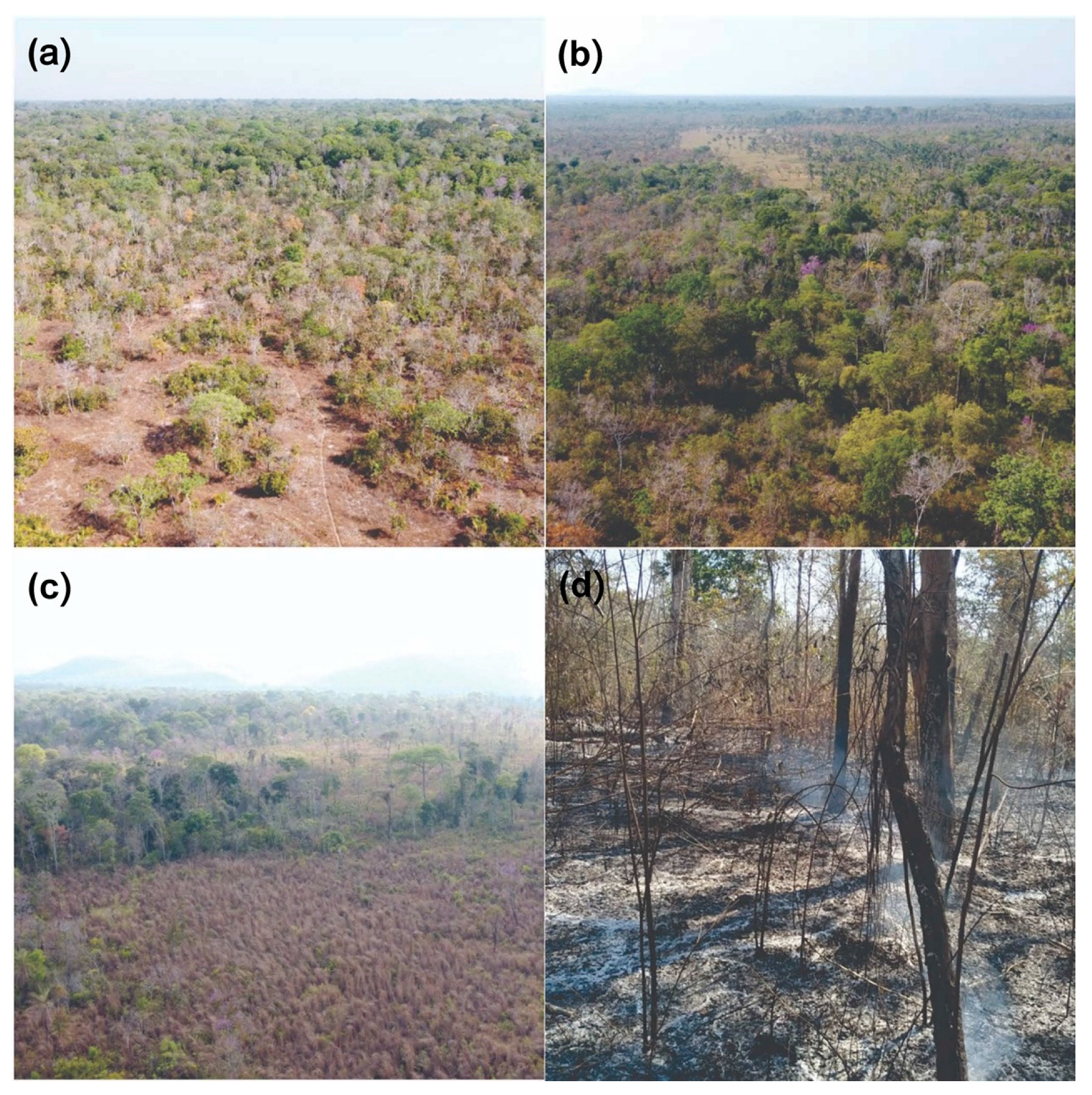

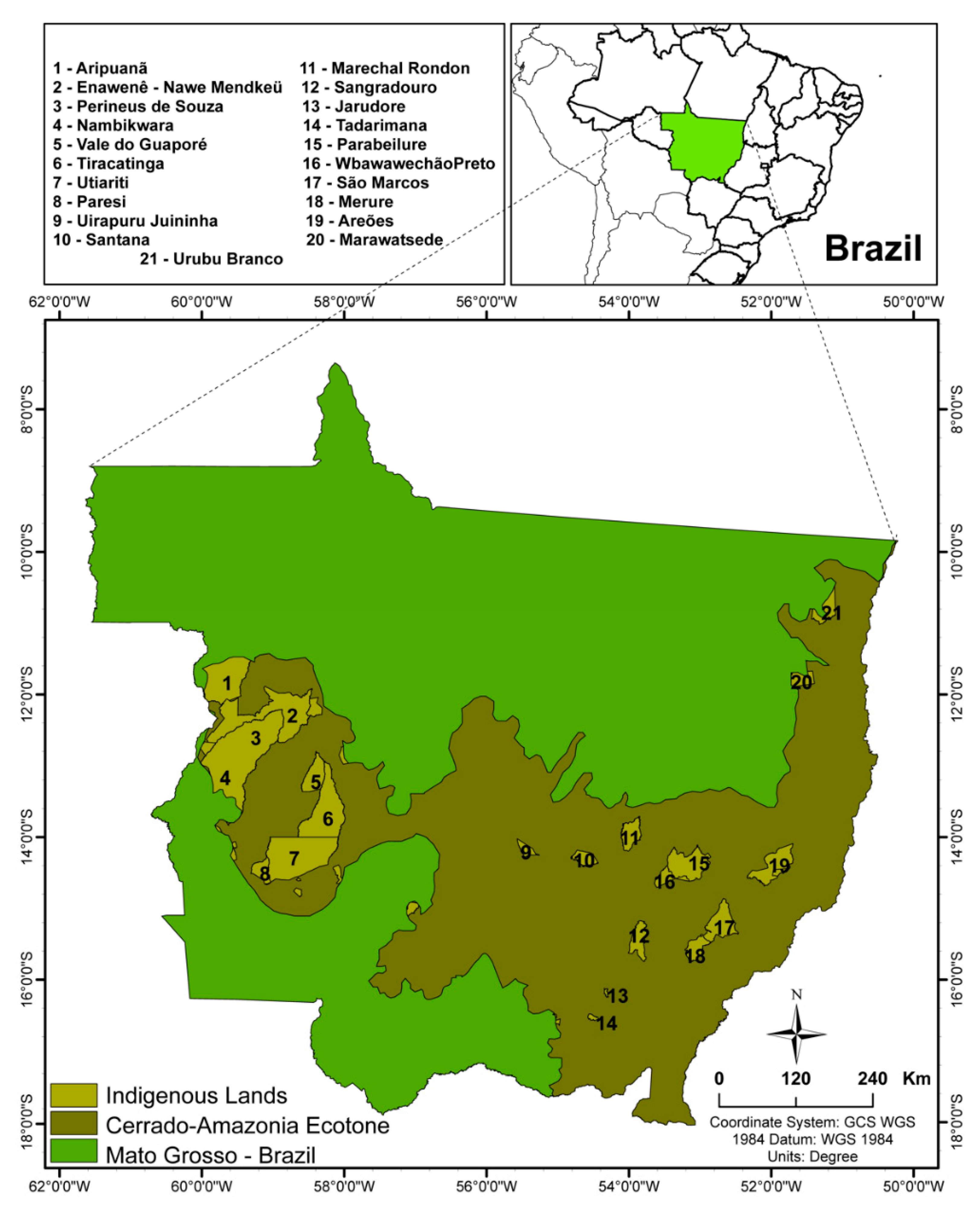
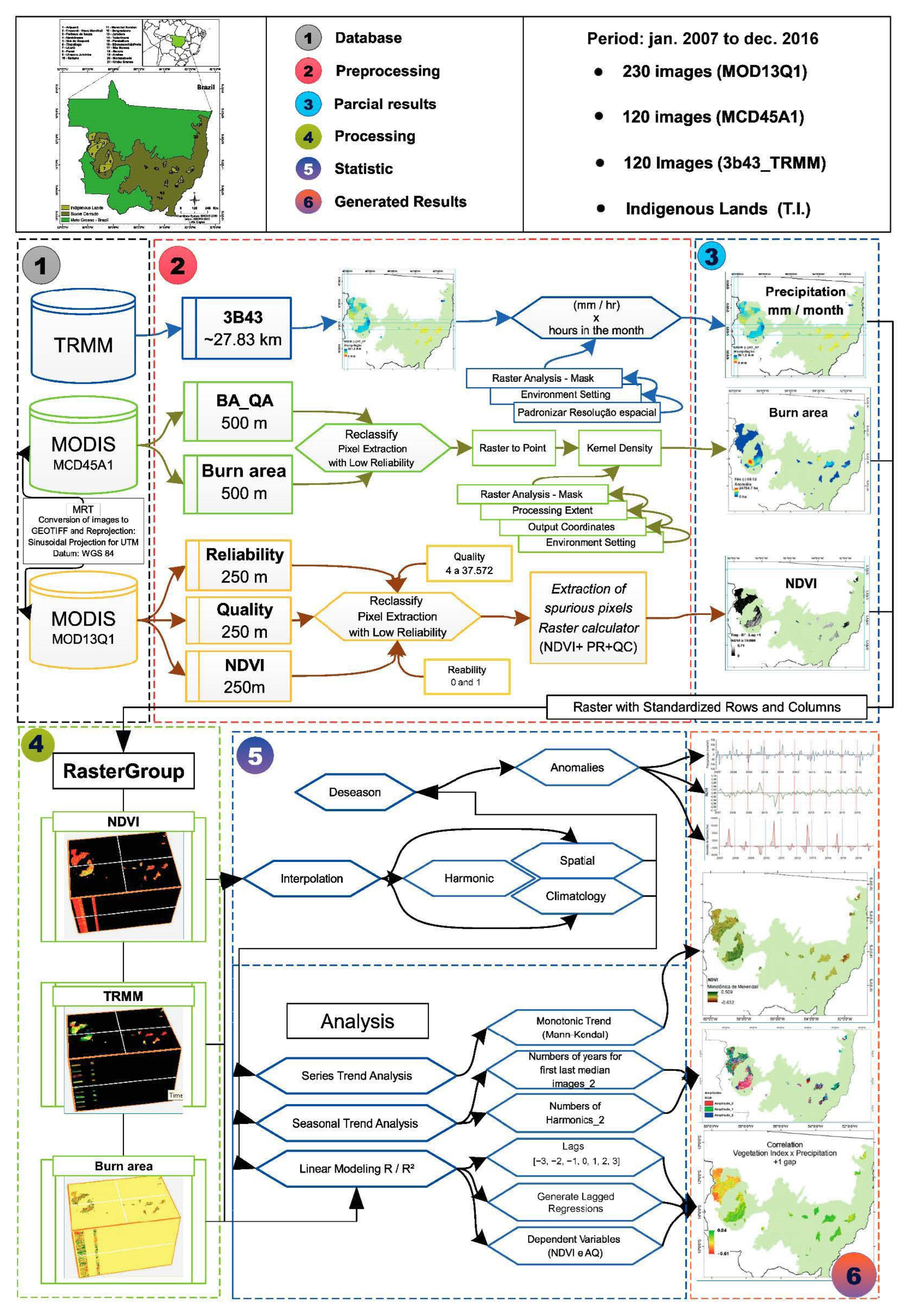
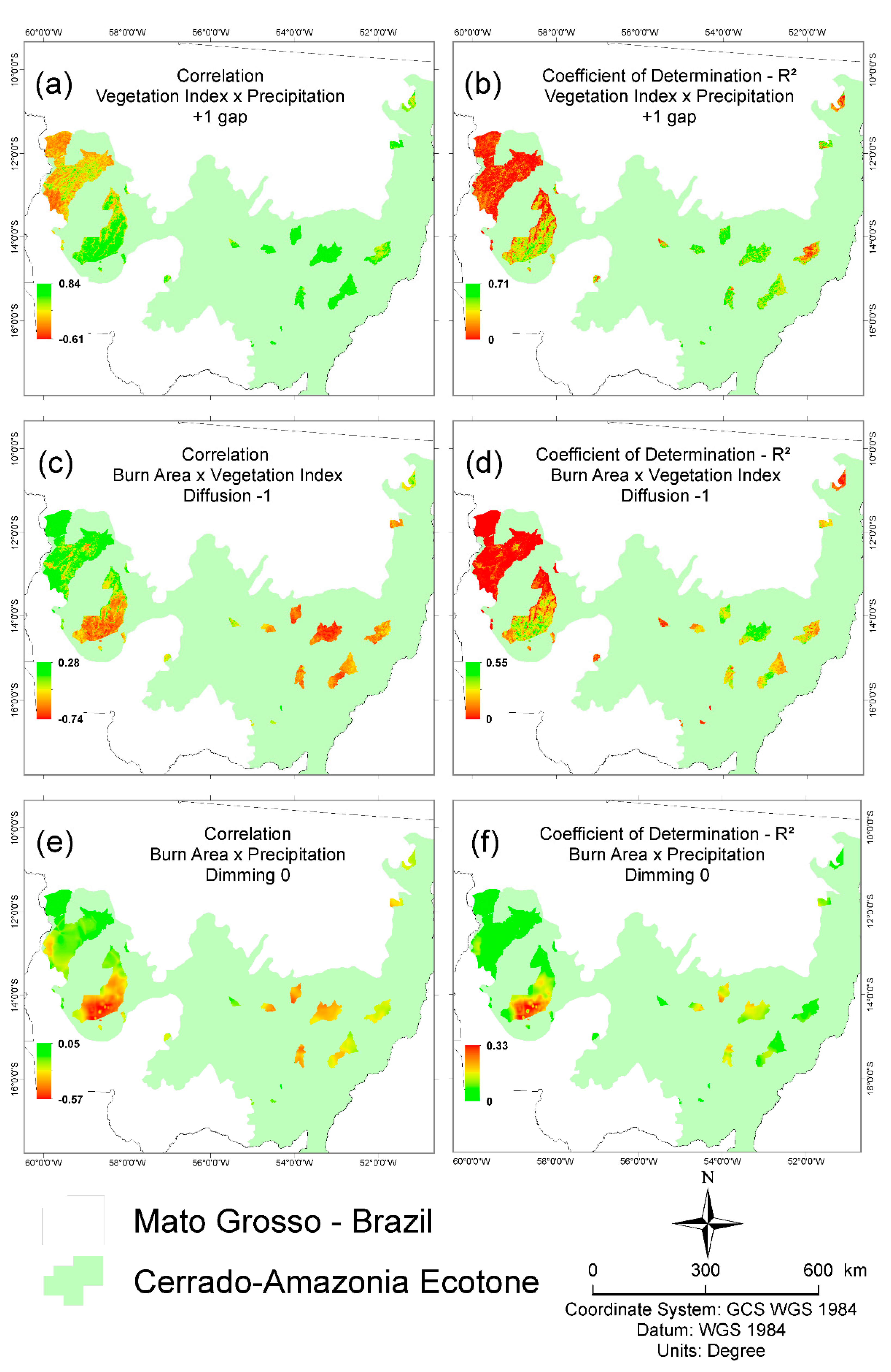
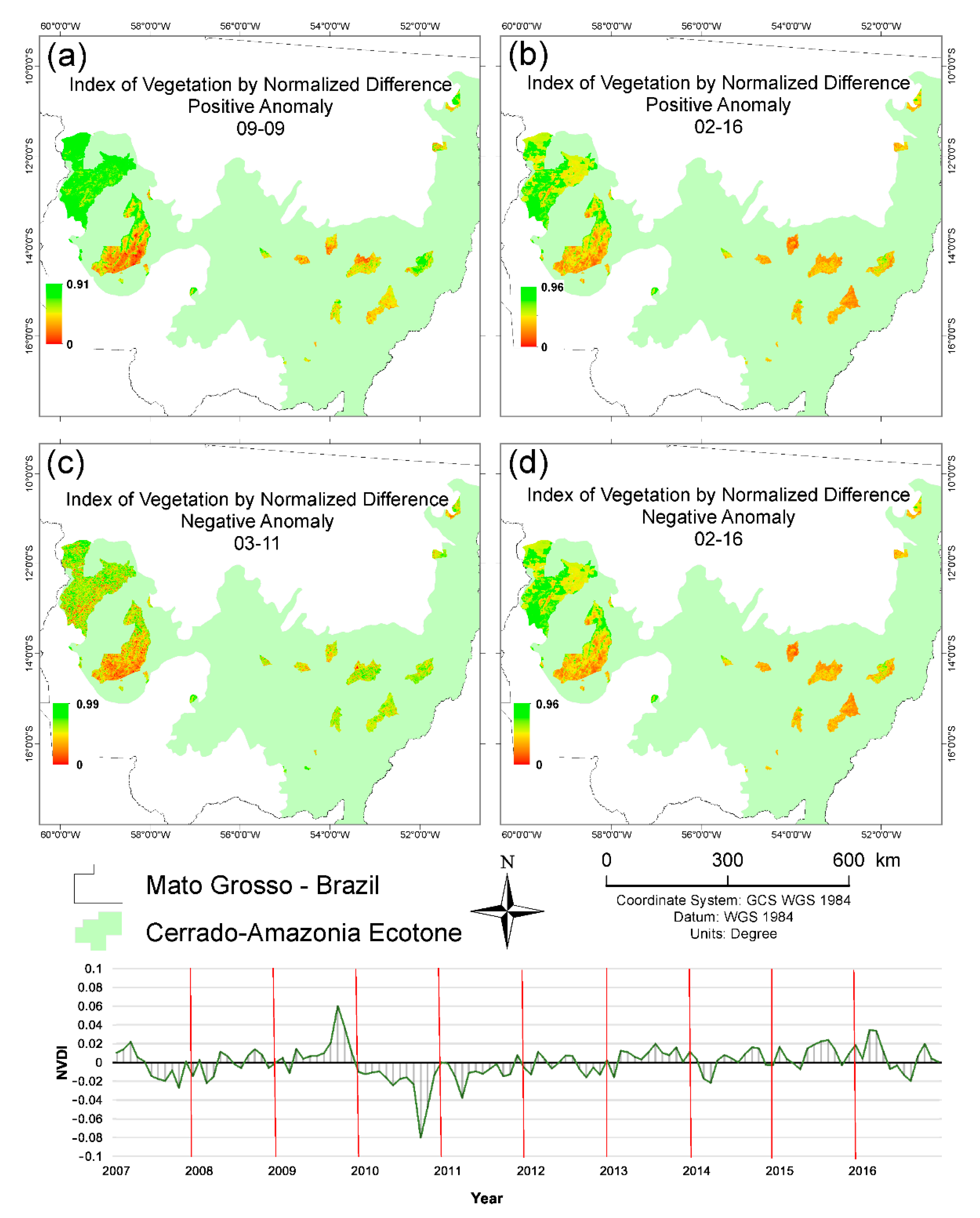
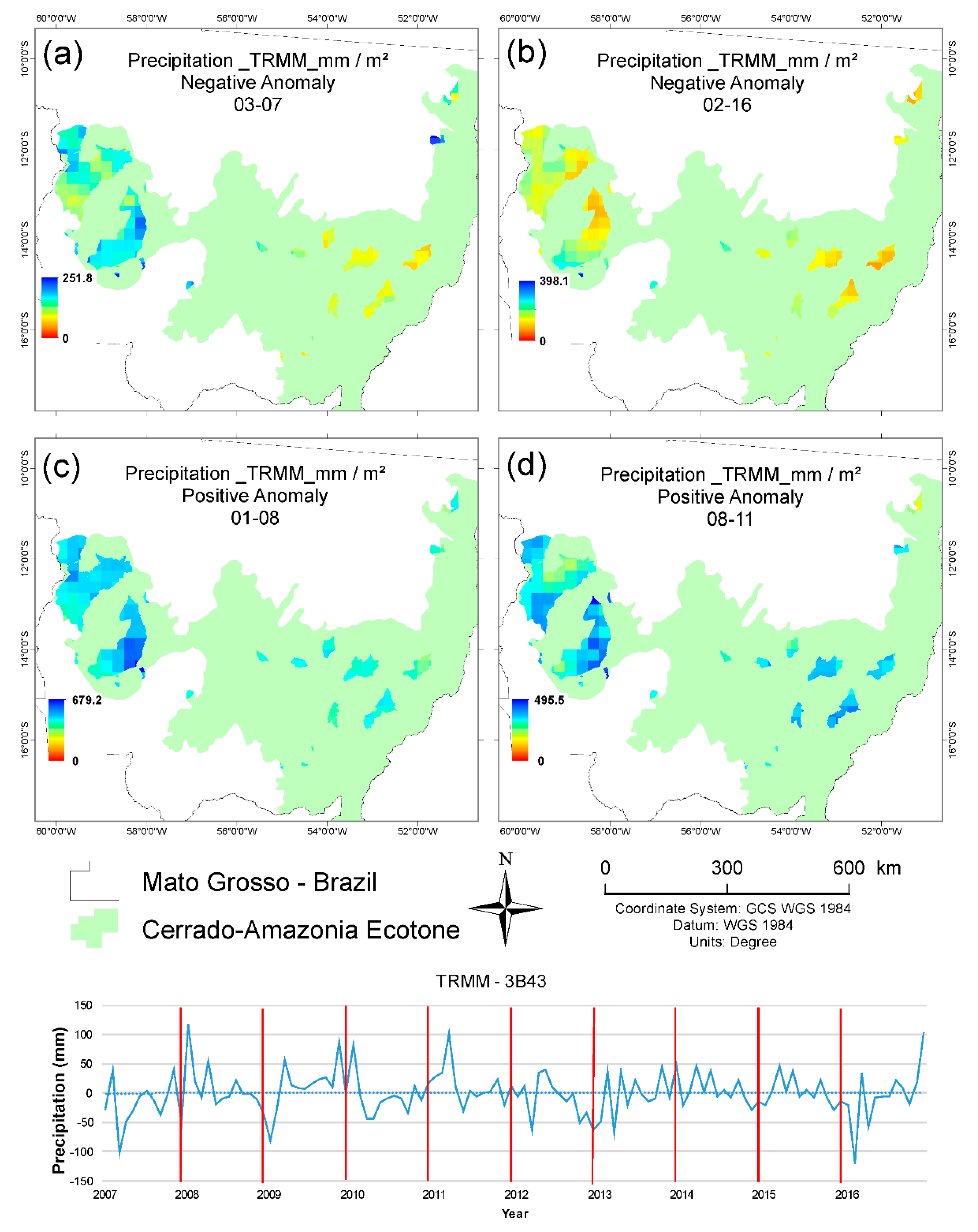
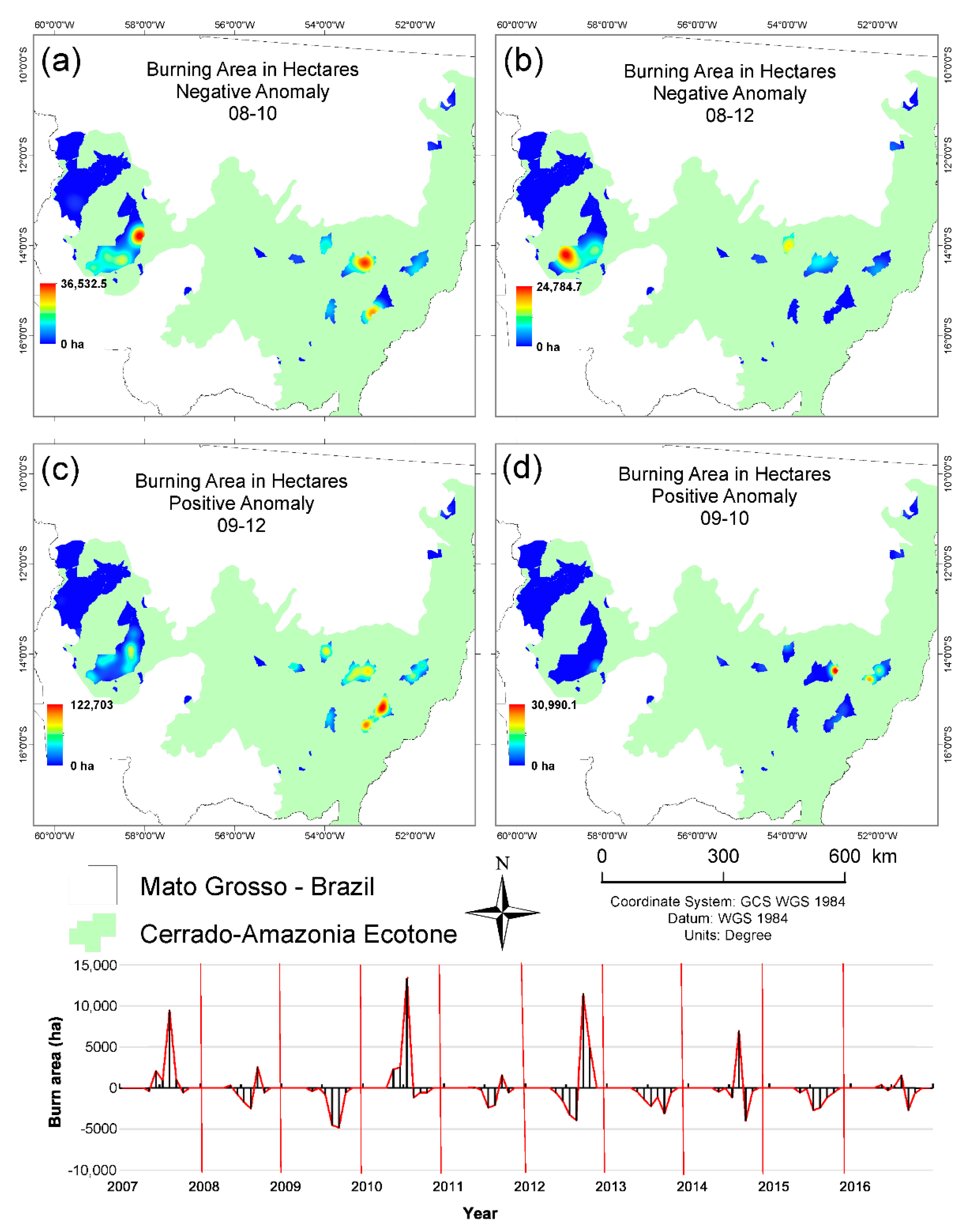
| Pixel Value | Quality | Description | Assigned Value after Reclassification |
|---|---|---|---|
| 0 | Good Data | High degree of reliability | 0 |
| 1 | Marginal data | Can be used, but look at other quality information | 0 |
| 2 | Snow and ice | Target covered with ice or snow | NoData |
| 3 | Clouds | Data affected by the presence of clouds | NoData |
Publisher’s Note: MDPI stays neutral with regard to jurisdictional claims in published maps and institutional affiliations. |
© 2022 by the authors. Licensee MDPI, Basel, Switzerland. This article is an open access article distributed under the terms and conditions of the Creative Commons Attribution (CC BY) license (https://creativecommons.org/licenses/by/4.0/).
Share and Cite
Rodrigues Silva, F.G.; Santos, A.R.d.; Fiedler, N.C.; Paes, J.B.; Alexandre, R.S.; Guerra Filho, P.A.; Silva, R.G.d.; Moura, M.M.; Silva, E.F.d.; Silva, S.F.d.; et al. Geotechnology Applied to Analysis of Vegetation Dynamics and Occurrence of Forest Fires on Indigenous Lands in Cerrado-Amazonia Ecotone. Sustainability 2022, 14, 6919. https://doi.org/10.3390/su14116919
Rodrigues Silva FG, Santos ARd, Fiedler NC, Paes JB, Alexandre RS, Guerra Filho PA, Silva RGd, Moura MM, Silva EFd, Silva SFd, et al. Geotechnology Applied to Analysis of Vegetation Dynamics and Occurrence of Forest Fires on Indigenous Lands in Cerrado-Amazonia Ecotone. Sustainability. 2022; 14(11):6919. https://doi.org/10.3390/su14116919
Chicago/Turabian StyleRodrigues Silva, Felipe Gimenes, Alexandre Rosa dos Santos, Nilton Cesar Fiedler, Juarez Benigno Paes, Rodrigo Sobreira Alexandre, Plinio Antonio Guerra Filho, Rosane Gomes da Silva, Marks Melo Moura, Evandro Ferreira da Silva, Samuel Ferreira da Silva, and et al. 2022. "Geotechnology Applied to Analysis of Vegetation Dynamics and Occurrence of Forest Fires on Indigenous Lands in Cerrado-Amazonia Ecotone" Sustainability 14, no. 11: 6919. https://doi.org/10.3390/su14116919
APA StyleRodrigues Silva, F. G., Santos, A. R. d., Fiedler, N. C., Paes, J. B., Alexandre, R. S., Guerra Filho, P. A., Silva, R. G. d., Moura, M. M., Silva, E. F. d., Silva, S. F. d., Silva, S. G. d. O. S. R., Cessa, R. M. A., Ferreira, W. A., & Marinho, F. G. (2022). Geotechnology Applied to Analysis of Vegetation Dynamics and Occurrence of Forest Fires on Indigenous Lands in Cerrado-Amazonia Ecotone. Sustainability, 14(11), 6919. https://doi.org/10.3390/su14116919







